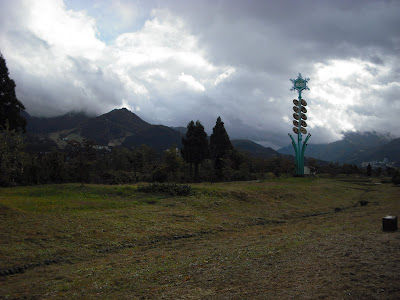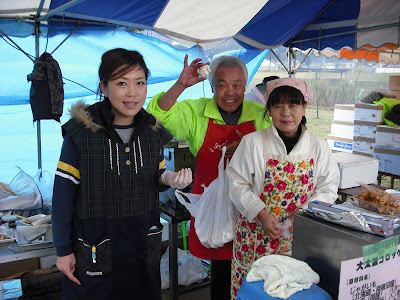* It's sad to say that this fair, the 20th this year, will end this year.
日本では、11月3日は文化の日で、国民の祝日です。毎年*、この日に、しおざわ産業まつりが今泉博物館の敷地で行われます。
* 残念なことに、今年20回目のこのお祭りは今年で終了します。
Backyard of the Museum:
The upper part of the tower on the right reads, "You are in Uonuma", the middle right part reads, "Shiozawa", and the middle left part reads, "Koshihikari". The bottom part represents ears of rice.
You can also see Mt. Iiji (1,111.8 meters in height), also known as Ueda Fuji, on the left.
博物館の裏庭:
右側の塔の上部には「ここは魚沼」、中央の右側には「しおざわ」、中央の左側には「コシヒカリ」と書かれています。下の部分は稲穂を表しています。
飯士山(いいじさん)(標高1,111.8メートル)、別名「上田富士」(うえだふじ)も左側に見えます。

It was raining today, and I didn't particularly want to come to this fair, but I had an important mission: taking photos of the mushroom booth for my son, who couldn't make it to this fair because of a cold. As soon as I reached the site, I headed for the booth.
今日は雨が降っていて、私は特にこのお祭りに行きたくはなかったのですが、重要な任務がありました。風邪のためこのお祭りに来れない息子のためにキノコのブースの写真を撮る、ということです。会場に着くと、真っ先にそのブースに向かいました。

I took this test, answered all ten questions right, and got a prize (a pack of enoki).
このテストを受け、10問全て正解して、賞品(エノキ1パック)をもらいました。

Here are many of the photos of edible and poisonous mushrooms that I took.
私が撮った食用、毒キノコの写真です。
Kuri take in the middle:
中央にクリタケ:





Hiratake (oyster mushroom) in the middle bottom and tsukiyo take in the left bottom:
中央・下にヒラタケ、左下にツキヨタケ:

Tsukiyo take is the most common source of mushroom poisoning in Japan.
日本では、ツキヨタケがキノコによる中毒の最も多い原因です。
Muki take in the right bottom and shiitake in the middle bottom:
右下にムキタケ、中央・下にシイタケ:

Hon shimeji on the right side of the upper left tray:
左上のトレイの右側にホンシメジ:

One of my son's dreams is to gather hon shimeji, which is hard to find.
息子の夢の一つは、見つけにくいホンシメジを採ることです。
Nameko in the center of the photo:
写真の中央にナメコ:

Booth of an izakaya called Oodaiko (Big Drum):
大太鼓という居酒屋の売店:

Man and wife and their daughter:
夫婦とその娘さん:

Their daughter happens to be an acquaintance of mine. I bought four korokke (Japanese croquettes) for 100 yen each.
娘さんは私の知り合いです。コロッケを4つ(一つ100円)買いました。
Inside Imaizumi Museum, Ojiya-chijimi and Echigo-jofu were on display. In Japan, they are designated as important intangible cultural properties. They are also registered in UNESCO's list of Intangible Cultural Heritage.
今泉博物館内では、小千谷縮、越後上布が展示されていました。日本では、重要無形文化財に指定されています。また、ユネスコの無形文化遺産にも登録されています。

An example of Echigo-jofu:
越後上布の一例:

(Sorry, blurry.)
(ボケた写真ですみません)
Many events were held on the site, such as "Kome-lympic", where teams competed over who could move bales of rice from one location to another the fastest.
会場では多くのイベントが行われました。例えば、どのチームが米俵を一箇所から別の場所に一番速く動かせるかを競う「コメリンピック」などです。

Left: A pack of enoki that I got as a prize.
Right: Korokke (Japanese croquettes) that I bought at the izakaya booth shown above.
左: 賞としてもらったエノキ1パック。
右: 上述した居酒屋の売店で買ったコロッケ:

Mikan:
みかん:

This quantity of mikan for 500 yen. Quite reasonable.
これだけの数のみかんで500円。とてもお買い得です。
No comments:
Post a Comment